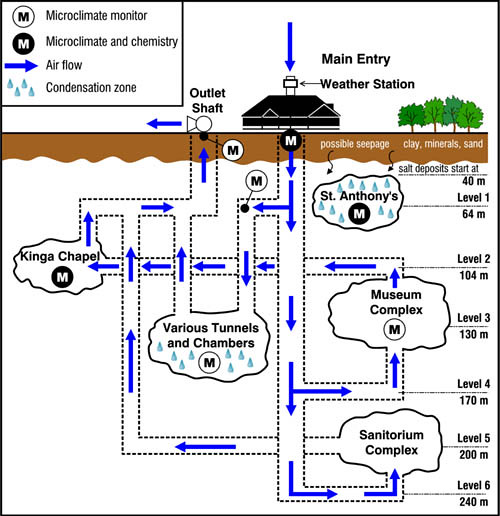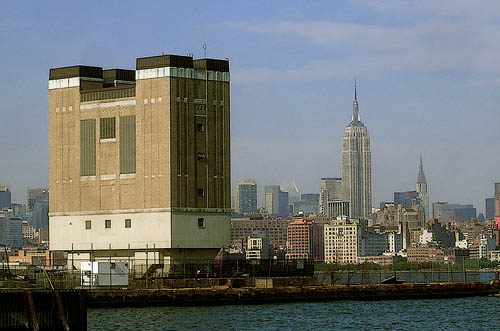Ventilating Mines with Repurposed Airplane Engines
 [Image: A "Jeffrey Portable Blower," once billed as the "highest efficiency in mine ventilation, insuring [sic] a continuous and abundant supply of fresh air under every operating condition." Image courtesy of Kentucky Coal Heritage].
[Image: A "Jeffrey Portable Blower," once billed as the "highest efficiency in mine ventilation, insuring [sic] a continuous and abundant supply of fresh air under every operating condition." Image courtesy of Kentucky Coal Heritage].I had never heard of a "Gorniczy Agregat Gasniczy" apparatus prior to the Pike River Mine disaster still unfolding in New Zealand, where one such device is about to be deployed.
The GAG, as it's known, is "a jet engine inertisation unit developed for use in mines, controlling and suppressing coal seam fires," Wikipedia explains—another way of saying that it is literally a jet engine that you plug into one end of a sealed mine in order to blow high-powered chemical winds (carbon dioxide, nitrogen, and water vapor) into the tunnels below. These gases then "lower the oxygen levels, suppressing fires and forcing methane out of the mine."
 [Image: A GAG unit being readied in New Zealand, courtesy of the New Zealand Herald News].
[Image: A GAG unit being readied in New Zealand, courtesy of the New Zealand Herald News].There are only three operational GAG units in the world right now, apparently. Each operates by taking a "docking position" on the earth's surface, attached to "intake ventilation headings" that lead, via boreholes, into the porous labyrinth of artificial caves below. The GAG then rapidly pumps a new atmosphere into the existing mineworks, as if generating artificial weather underground. In a paper on "jet engine inertisation techniques," Stewart Bell points out that "a variation of this device was used, mounted on a remotely controlled tank, to extinguish the oil well fires in Kuwait following the Gulf War."
As Jonathan Rennie, the person who originally pointed this machine out to me, added: "I wonder what alternative structures it could be plugged into and what alternative gases could be pumped." Indeed. Weaponized jet-engine army battering rams used to clear enemy houses of hidden combatants. Emergency subway ventilation machines. Alcoholic mist-dissemination units for avant-garde cocktail parties. Underground deodorant guns.
As it happens, the specialty subfield of preventing and/or extinguishing underground mine fires comes with a wide range of spatial and material techniques. These include the controlled "injection" of instant gel-foam barriers (operated via "an underground-based mobile gel preparation and injection system"), in order to block airflow through the mines, and the installation of ventilation control devices (VCDs), or rapidly deployed explosive barriers.
Looking into this latter architectural form—if we can treat underground ventilation control devices as a form of spatial design—led me to something called the "TestSafe Explosions Gallery" in Queensland, Australia—a kind of experimental underground explosion lab that operates as "a full-scale pressure test facility for ventilation control devices (VCDs) within Australia."
 [Image: The Lake Lynn Experimental Mine facility; image courtesy of the CDC].
[Image: The Lake Lynn Experimental Mine facility; image courtesy of the CDC]. This "full-scale pressure test facility" joins another Aussie site, called the Lake Lynn Experimental Mine (LLEM), "a highly sophisticated underground and surface facility where large-scale explosion trials and mine fire research is conducted."
The workings are located in a massive limestone deposit. Entries are sized to match those of commercial mines, making them authentic, full-scale test galleries. Movable bulkheads permit the setup of single-entry, triple-entry, and longwall face configurations for experiments. The underground test areas are amply instrumented and coupled to a remote control center at the surface. Research conducted at this facility includes large-scale gas and coal dust explosion studies, conveyor belt flammability trials, and evaluations of explosive materials and mine stoppings. In addition, diesel, ground control, and emergency response and rescue research is conducted here.I'm increasingly convinced that these sorts of highly specific sites need to be cataloged within the architectural world—or, at the very least, within the world of landscape research and design. Put another way, in the long line of accepted building typologies—the library, the stadium, the prison, the house, the theater—it's a shame not to see mine-fire research facilities more frequently listed...
In any case, Jonathan Rennie, who first pointed out Gorniczy Agregat Gasniczy devices to me, also forwarded a link to the homepage of Andrzej M. Wala, a mine engineering professor at the University of Kentucky with a research focus on subsurface ventilation techniques—mapping and predicting atmospheric effects in highly confined quarters below ground. As part of this, Wala has pioneered work in simulating the spread of underground fires using VENTGRAPH "mine fire simulation software" (as opposed to VENTSIM "mine ventilation simulation software").
"The essential work program of the project," Wala and his co-authors explain, "was built around the introduction of fire simulation computer software and the consequent modeling of fire scenarios in selected mine with different layouts." At stake here is a comprehensive understanding of the geometry of underground airflow:
The importance of understanding complex ventilation networks such as those with diagonal connections has been discussed. It is important to identify and understand their potential effects on the mine ventilation network as the airflow through the diagonal connections could reverse or stop due to the changes in the adjoining branches within the ventilation network. Mining companies need to identify the existing and potential diagonal connections in their ventilation system and analyze how these connections will affect their ventilation system especially in the case of fires. Training is necessary to equip mine ventilation personnel how to identify and minimize diagonal connections in their ventilation system.Indeed, we read elsewhere, underground facilities are often subject to sudden, potentially disastrous "windblasts," an atmospheric effect generated under certain spatial conditions: "These conditions include the geological configuration and the dimensions of the mining excavation (mine layout)." It's like spatially-induced turbulence inside the earth.
 [Image: The Wieliczka Salt Mine and its surface weather station; image courtesy of NOAA].
[Image: The Wieliczka Salt Mine and its surface weather station; image courtesy of NOAA]. So there is weather underground, then. In fact, it is interesting to note in this context that the famed Wieliczka Salt Mine outside Krakow, Poland, has its own weather station monitoring the atmospheric conditions underground. The station operates in tandem with a distributed network of microclimate sensors and a massive dehumidification system: "Although the dehumidification system is not yet operating exactly as desired... 'tuning' of the dehumidification system is planned and is expected to completely solve the mine's moisture problem."
I'm reminded of a passage from the Aeneid that I often cite here on BLDGBLOG, in which Virgil describes the underground storm-storage facilities of King Aeolus, who "rules the contending winds and moaning gales" of the Mediterranean by "imprisoning" them inside artificial caves that he has excavated beneath the "granite of high mountains." A kind of mythic weather-emperor, King Aeolus exhibits a knowledge of underground atmospheric dynamics that the programmers of VENTGRAPH and the operators of the Wieliczka dehumidification system should envy.
 [Image: Holland Tunnel exhaust tower, ventilating the underworld; photo via SkyscraperPage.com].
[Image: Holland Tunnel exhaust tower, ventilating the underworld; photo via SkyscraperPage.com].Finally, all this talk of subterranean ventilation compels me to mention David Gissen's short history of New York's urban ventilation control structures—specifically, the design of exhaust towers for the Holland Tunnel.
In a brief section of his recent book Subnature: Architecture's Other Environments, Gissen describes these structures as "strange buildings" that "collapsed" the difference between architecture and civil engineering:
The Holland Tunnel spanned an enormous 8,500 feet. At each end, engineers designed ten-story ventilation towers that would push air through tunnels above the cars, drawing the vehicle exhaust upward, where it would be blown back through the tops of the towers and over industrial areas of the city. The exhaust towers provided a strange new building type in the city—a looming blank tower that oscillated between a work of engineering and architecture.The very idea here that urban infrastructure—such as trans-river commuter tunnels or an underground subway—might be atmospherically comparable to deep coal mines is fascinating; the possibility that spatial techniques learned in one of these fields might be equally applicable in the other is equally of interest.
It is these moments of marginal, shared spatial expertise that continue to fascinate me, offering, as they do, unexpected perspectives on the built environment—both above and below the ground.
(Meanwhile, check out this image of 16th-century mine ventilation works, in which "revolving wooden wind vanes fitted to the top of mine ventilation shafts... acted as extractor fans sucking stale air from the mine.")





Comments are moderated.
If it's not spam, it will appear here shortly!
The environmental angle is what makes this really fascinating. Underground coal fires are a massive source of Carbon Dioxide emissions -- maybe as much as all US road traffic. And putting them out is an incredible technical challenge.
So I can't help daydreaming about the kind of organization that could put out the fires. A band of idealistic engineers -- top graduates from Caltech and IIT, grizzled mechanics who've spent decades underground, geologists whose morals wouldn't let them stay in the oil industry. They're funded by a philanthropic tech billionnaire, or perhaps just from carbon offsetting. Together they cross the world, dragging exotic equipment and wrangling McGyver-like contraptions to deal with each mine. One day they land Thunderbird One in Centralia, point the engines down one of the shafts, and finally put out the fires that have been burning for decades.
On the 19th of this month, it will be two years to the day since the Pike River mine exploded, killing 29 men.
Their bodies are still in the mine and there now seems to be no chance of the bodies being recovered. See a recent video on this at http://www.3news.co.nz/Pike-River-Mine-families-feeling-abandoned-by-Prime-Minster/tabid/367/articleID/272810/Default.aspx
Post a Comment